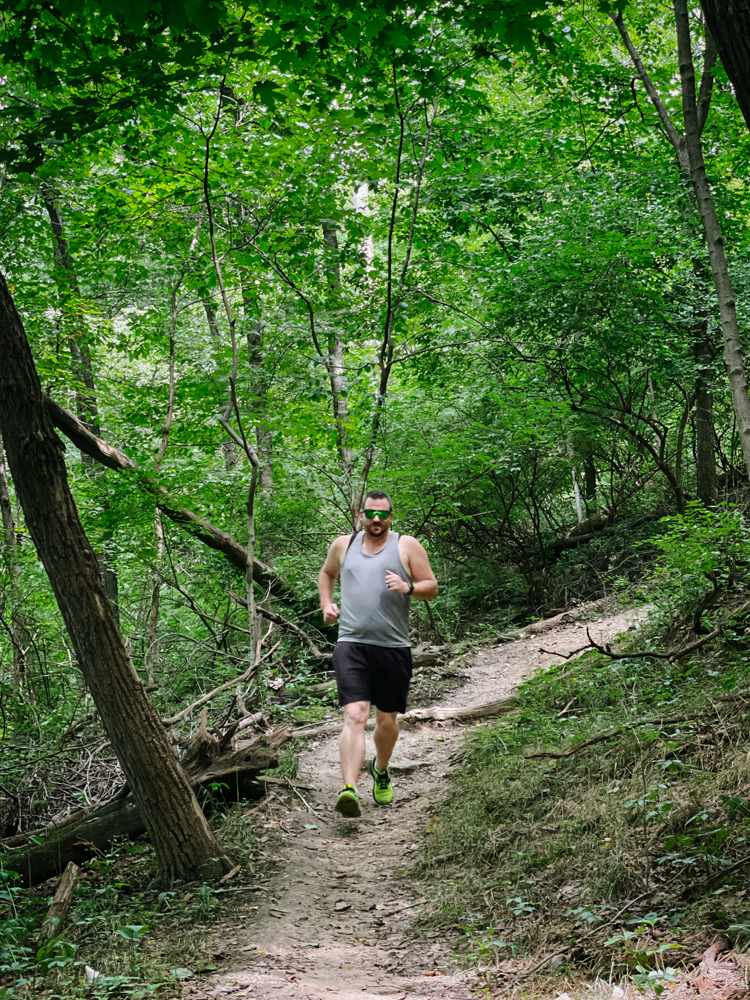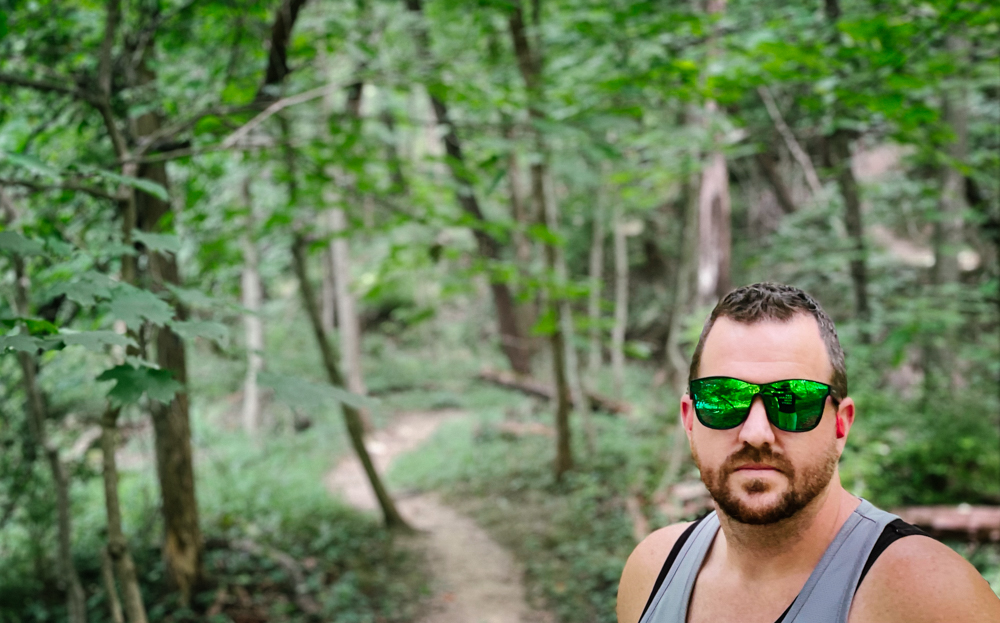

Beside him, two looming intake towers rose up out of the water like castle turrets. The squat, conical spire on the tower nearest to shore glowed pale green against the opaque morning sky. Some distance away, nearly eye-level with the bridge, an egret glided silently toward a thick stand of elm trees along the far bank. A smattering of small boats drifted at anchor between the hulking concrete pylons below, the faceless men onboard casting lures into the current. To the south, set low against the horizon, the St. Louis skyline spread out dusty and grey in the August heat like a solemn oasis. “It was serene,” says Patrick. “It was a beautiful, breathtaking place, standing over the river.”

With him on the bridge that morning were more than sixty other runners, all having gathered to fundraise on behalf of St. Jude Children’s Research Hospital. Divided into teams, they’d spend the next two days running a relay, traveling more than 176 miles along spalling county routes; running on narrow, brittle shoulders and main streets through small Illinois towns like Bath and Havana, stopping to rest at gas stations and bingo halls, until they reached the Civic Center in downtown Peoria.
He was, after all, lucky to be alive. In December 2020, doctors diagnosed Patrick with liver failure. “That will wake you up quickly,” he says. “Unhealthy habits had developed in my life. I was 300 pounds and drinking more than the average person. I was still responsible—I had a full-time job and kids—but, looking back, it all makes sense. At the time, I just didn’t realize it.” After three days of labs and imaging scans, the doctor’s prognosis was bleak. “I was given a 50% chance that my liver would work again. But if things went wrong, it was a ninety-day mortality rate.”

While still admitted in the hospital, he and his wife, Jami, began developing a plan to overhaul their lifestyle. “We very much took this on as a team,” says Patrick. “That’s kind of how we’ve always worked. This is the problem; how do we fix it?” Any dietary changes Patrick would have to endure, so too would Jami. That was the deal. They met with a nutritionist and Jami began exploring recipes that were both sodium and sugar free. She understood that in order for Patrick to stick with a new diet, it was imperative to find things he liked. “I went full force,” says Jami. “I researched healthy eating and smoothies. I joined a Facebook group. I made lemon water to help remove bilirubin from his system. Whatever I could do to get him nutrients, I did. I probably spent 500 hours in the kitchen making sure we had healthy food.”
“Weight was falling off my body,” says Patrick. “I went to the doctor, and they said I needed to start working out. My body needed muscle.” Photos taken of Patrick during this period are difficult for him to look at. “My body was a potato with twigs sticking out of it. I was extremely happy to be alive, but it was frustrating to realize how unfit I was. I’ve never had much interest in working out. I don’t know how to lift. I don’t understand how to build muscle. So, I just decided to eat right and run.”
Patrick had tried running before. Years back, he’d even completed a half marathon. “Unfortunately, when I crossed the finish line, I stopped running and went back to eating junk food,” says Patrick. “I’d met my goal and that was the end of it. But I like the idea of being able to run for a long period of time. It’s hard. Not a lot of people are able to do it. And I wanted to be one of them who are.” Patrick began setting small goals for himself. He liked how a quarter mile could slowly evolve into a mile, then another, and another, without any undue pressure. Slowly, as he began to ratchet up the mileage, he could feel his body beginning to heal and his muscles beginning to tone. “I lost another twenty pounds,” says Patrick. “I’ve kept the weight off. I feel on top of my health and fitness more now than I ever did before all this.”
“The biggest heartbreak I felt throughout all this was my wife telling me that she didn’t want our kids growing up without their dad,” he says. “I always thought that sounded cliché, but it’s cliché for a reason. My kids are absolutely my best friends. They are the coolest people in my life. I am overly proud of them every single day, even when they’re driving me nuts. I can’t imagine not being here for them when they need me. It’s painful to think about. They’re what I look forward to; they’re what drives me.”
Back on the Old Chain of Rocks Bridge, Patrick grew anxious. “I was extremely nervous,” he says. “I had trained really hard for this, and I wanted to run every mile I possibly could.” Just before the relay began, the group listened as a fellow runner spoke of their own experience with St. Jude Children’s Research Hospital. “It was really touching,” says Patrick. “We got to hear how fantastic they had been treated. How insurance isn’t even a question, or, at least, not the first question. All these kids are going through trials most of us will never have to face at a young age. They just want to get the kids in there and taken care of.”
Cutting a jagged course through southwestern Illinois, past large swaths of corn and soybean, thorough unincorporated villages without so much as a church or a bar, on two-lane highways and backroads without markings, past strip malls and small industrial manufacturers, antique shops and fast-food joints, over hills that rose up in isolation, in 80% humidity and an AWOL breeze, Patrick just kept clicking off the miles.
As they entered Manito, a small town twenty-five miles outside Peoria, he felt a rush of familiarity. At one point, Patrick had been a volunteer firefighter in town. In fact, it was how he came to know about the St Jude relay. “The fire department would escort the runners through our district, and they’d stop for lunch at our firehouse,” he says. “I met some of the runners. They were always poking at me to get involved, but I was never healthy enough to do it.”

“The reception we got heading into town—seeing our friends and family, our husbands and wives all cheering us on—it was really special to see everybody come out and support us. On a hundred-degree day, we were greeted with water guns and hoses. It was really cool.”
Reflecting on his experience, what stands out most to Patrick about that weekend is the camaraderie that developed between runners. “The whole experience was reminiscent of summer camp. You go away with all these people you don’t know, and by the end of that couple of days it’s like you have a bunch of new best friends. It’s really a special thing. It’s a bond you share.” And those are the things that matter, the heightened experiences that forever bind you with another person—be it your wife, your child, or a complete stranger. Those are the things you carry with you when things get dark.
When it was all over, Patrick had run more than eighteen miles. A remarkable turnaround given the prognosis he’d received less than two years ago. “I know now that if I keep doing this, I am going to see results,” he says. “I needed to see that. I needed to understand that it’s going to suck while I do it, but, so long as I continue, there’s fruit that will come of it later on.”
“He’s determined,” says Jami. “He loves his kids, and he wants to fight for his kids. The negativity is out. We don’t have time for it anymore. We have time for raising our boys and spending our life doing what we want to do, what we love to do. If your husband had been given a 50/50 chance of living, you would do that too.”
